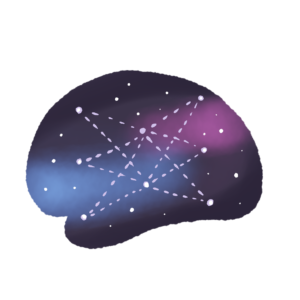By Minseok Kang

Before cognitive science
People were curious about how the mind works even before cognitive science started as a discipline. As with all other disciplines, philosophers were the first to have asked how the body and mind are related to each other, and since the earliest investigations of the mind, philosophical differences of opinions have led to new approaches and ways of thinking about cognition, which continues to this day [1].
The first successful attempt to study the mind empirically was made by Wilhelm Wundt [2], who insisted that psychology should also use experimental methods as in other disciplines of natural science.
In the 1930s, the field of psychology became dominated quickly by the idea that the mind is a “black box,” suggesting that researchers should focus on understanding the behaviours (or “outputs”) that resulted from different stimuli (or “inputs”) in the world. This idea — also known as radical behaviourism — was made popular by Skinner [3].

How it all started – cognitive revolution
In the 1950s, several researchers from different fields including psychology, linguistics and artificial intelligence felt the need for a new paradigm other than behaviourism to explain the mind [4]. This movement later became a coherent discipline known as cognitive science.
The core idea of the movement was to view the mind as a symbol manipulation system in which people mentally represent the outside world through symbols, providing correspondence between the world inside a head and the world outside it. Thinking, then, took place through Turing style computations on the symbols [5]. Throughout this article, we will refer to this school of thought as cognitivism [6].
Under this assumption, it is natural to consider a system that is capable of manipulating symbols to be cognitive. This means we might be able to build an intelligent machine – artificial intelligence – by building a system that manipulates propositions following fixed rules (i.e. logical deduction). This type of AI is known as symbolic AI. These AI proved to be powerful in a given expert domain (e.g. deep blue mastering the game of chess [7]), but were not able to make decisions based on contexts — for example, they could not determine what information was most relevant for their current situation.

Implementational connectionism
Connectionism is an approach to explain the mind in terms of artificial neural networks (ANN), which are models of cognition that are structurally similar to the brain. At the end of the day, our brain is indeed a neural network made out of neurons and synapses between them. Another advantage of connectionism is that the representation is distributed around the whole network as opposed to corresponding to symbols through 1-to-1 representations. This ensures that the system does not completely break down when there is a bit of noise in stimuli, which is a situation humans face all the time and are very good at solving. In the connectionist’s framework, a representation of a complex thought need not contain explicit representations of every part constituting the thought. For this reason, AI based on ANN is often called sub-symbolic AI.
However, there have been oppositions from cognitivists. They have pointed out that connectionists cannot explain higher cognition capacities such as reasoning and language without resorting to the computationalist’s model of symbolic manipulation [8].
Here, we need to make a distinction between two flavours of connectionism. Implementational connectionists think that cognitivism and connectionism need not be in conflict with each other. The difference between the approaches is merely at the level of analysis. While cognitivists are more interested in higher-level phenomena like reasoning and language, the connectionist’s job is to explain how these functions can be implemented by a network of neurons. Thus implementational connectionism can be thought of as enriching, rather than in conflict with, cognitivism. In comparison, more radical connectionists think conceptualizing the mind as a symbol manipulator is just a bad explanation and should be eliminated [9].

Enactivism
Enactivism argues that cognition is best understood as an emergent phenomenon that arises depending on the dynamics between an organism and its environment [10]. For enactivists, we cannot make sense of cognition if we leave aside the environment in which the organism finds itself in.
I would like to stress how the difference between enactivism and cognitivism is not simply a technical matter – which cognitivism vs connectionism debates often tend to be – but one that is more deeply rooted in different philosophical starting points. cognitivism has its philosophical root in Descartes, whereas enactivism has its root in Heideggerian philosophy.
The subject-object dichotomy put forward by Descartes was at the core of the early development of cognitive science [11]. According to this idea, the objective world is populated with meaningless substances and properties. It exists independently from the subject that makes sense of this world. At first glance, this seems like a trivial acknowledgement that there exists a pre-given world independent of the subject’s perspective. The interesting problem is rather on the statement that follows from this dichotomy – namely that the subject needs a process of gaining access to the knowledge about the objective world. One natural way to explain this process is to assume that the mind of the subject encodes states of the world (i.e. representation).
For Heidegger, this way of conceptualising a subject-object relation makes an important mistake- it assumes that the subject can stand independent of its world [12]. For Heidegger, this is not true. Rather, we are always situated inside a world that presents itself as a meaningful construct and we can never step outside of it to gain access to the ‘value neutral view’. Enactivism thus seems to be able to account for how dynamics between an environment and an autonomous agent enact (bring forth) a meaningful world for that agent by refuting to view subject and object as separable. This provides a solution to the problem of deciding on the significance of facts which cognitivists faced [13].
However, being an enactivist also comes with its own problem. Currently, complex thoughts are best understood in terms of representation. After all, the cognitive revolution was a response to the limitations of behaviourism. This means that at the moment, no paradigm has an absolute upper hand over other paradigms. Although each paradigm has its own way of explaining the phenomena and differences might arise from it, one has to commit to one position or another where incompatibility arises. How can we best paint a unified picture of how the mind works?
Timeline
Here, I provide lists of various landmark works in the history of cognitive science.
| Work/Author/Time | Explanation |
|
The Principles of Philosophy – René Descartes, 1644
|
Descartes’ formulation of the subject-object dichotomy
|
|
Founding the institute of experimental psychology – Wilhelm Wundt, 1879
|
Study of consciousness with methodologies from natural science
|
|
Being and Time – Martin Heidegger, 1927
|
Heidegger criticised how ‘being’ has been understood traditionally, providing a basis for enactivism in the future
|
|
The Behavior of Organisms: An Experimental Analysis – B.F. Skinner, 1938
|
Skinner’s study on operant conditioning and the popularisation of behaviourism
|
|
The Magical Number Seven, Plus or Minus Two: Some Limits on Our Capacity for Processing Information – George A. Miller, 1956 Syntactic Structures – Noam Chomsky, 1957 Elements of a theory of human problem solving – Newell et al., 1958
|
important publications triggering the cognitive revolution in fields of psychology, linguistics and artificial intelligence
|
|
Computer Science as Empirical Inquiry: Symbols and Search – Allen Newell and Herbert A. Simon, 1976
|
formulation of physical symbol system hypothesis
|
|
Parallel distributed processing – J.L. McClelland and D.E. Rumelhart, 1986
|
Landmark study of how artificial neural network can be used as a model of psychological process
|
|
The dynamical hypothesis in cognitive science – Tim van Gelder, 1998
|
radical connectionist approach using dynamical system theory to explain cognition
|
|
The embodied mind – Evan Thompson et al., 1991
|
first formulation of enactivism
|
|
Intelligence without representation – Rodney Brooks, 1991
|
behaviour-based robotics
|
|
Why Heideggerian AI failed and how fixing it would require making it more Heideggerian – Hubert Dreyfus, 2007
|
Why merely embodied-embedded approach is not sufficient and enactive approach is needed to make cognitive science fully Heideggerian
|
Footnotes
[1] Among the earliest, Rene Descartes advocated for a position called Cartesian dualism, which views subject and object as fundamentally different and separable.
[2] https://en.wikipedia.org/wiki/Wilhelm_Wundt#Starting_point
[3] https://en.wikipedia.org/wiki/Radical_behaviorism
[4] https://en.wikipedia.org/wiki/Cognitive_revolution#Historical_background
[5] A Turing machine is an abstract machine that can simulate any arbitrary computer algorithms despite its simple structure. The machine consists of memory locations of infinite length and a central processor that can access any location. The processor can either move to access another location, insert a new symbol or erase an existing one. Turing believed that the human capacity for thinking could be captured by this formalism.
[6] There are many similar but not equivalent theories relating to this idea. Allen Newell and Herbert Simon claimed that a physical symbol system is necessary and sufficient for general intelligence. The classical computational theory of mind (CCTM), put forward by Hilary Putnam and Jerry Fodor, posits that mind is a Turing-style computational system. The representational theory of mind (RTM) is an idea that symbols that are manipulated in a Turing computation take the form of propositions. Refer to https://plato.stanford.edu/entries/computational-mind/#ClaComTheMin for further distinctions.
[7] https://en.wikipedia.org/wiki/Deep_Blue_(chess_computer)#Design
[8] For example, Fodor and Pylyshyn pointed out that one must resort to a computationalist framework to explain the systematicity of language. https://www.iep.utm.edu/connect/#SSH6dii
[9] Tim van Gelder, for example, thinks that cognition is best modelled as a dynamical system. https://en.wikipedia.org/wiki/Dynamical_systems_theory#In_cognitive_science
[10] There are many ideas that are somewhat similar to enactivism, which are often referred to as 4E cognitive science. Some views became so distinct from each other that they are not necessarily compatible with each other anymore. For example, some of them think cognitivism and their approach is compatible and some don’t.
Embodied/embedded – cognition depends heavily on features of body/environments. Still shares the same fundamental philosophical origin with cognitivism.
Extended – cognition not only depends on, but is partially constituted by, environments
Situated – focus on the epistemological shift to constructivism, positing that all knowledge is bound within a given context
Please refer to chap.3.4. of Ward et al., 2017 for more descriptions of relations between these ideas and further distinctions among enactivism.
[11] Alongside, there are other ideas within rationalism that were implicit when the cognitive revolution took place. “They had taken over Hobbes’ claim that reasoning was calculating, Descartes’ mental representations, Leibniz’s idea of a “universal characteristic”—a set of primitives in which all knowledge could be expressed,—Kant’s claim that concepts were rules, Frege’s formalization of such rules, and Russell’s postulation of logical atoms as the building blocks of reality. In short, without realizing it, AI researchers were hard at work turning rationalist philosophy into a research program.”- Dreyfus, 2007
[12] Notice that Heidegger distinguishes the human world from the physical universe.
[13] Dreyfus criticised that computationalists run into the problem of significance representation. Minsky proposed to make use of “frames”, which store situation-relevant facts as pairs, which then leads to the frame problem: We live in a world that is constantly changing, so how can we know which representations are to be updated and which should stay the same? Even if we did, how can we ever be sure that the update was indeed successful? Dreyfus 2007 proposes a solution based on Freeman’s work in neurodynamics
References
- Thompson, E. (2007). Mind in Life: Biology, Phenomenology, and the Sciences of Mind. Phenomenology and the Cognitive Sciences. Cambridge, Massachusetts; London, England: THE BELKNAP PRESS OF HARVARD UNIVERSITY PRESS. https://doi.org/10.1007/s11097-008-9114-2
- Kiverstein, J. (2012). What Is Heideggerian Cognitive Science? In Heidegger and Cognitive Science. https://doi.org/10.1007/978-1-137-00610-3_1
- Dreyfus, H. L. (2007). Why Heideggerian AI failed and how fixing it would require making it more Heideggerian. Artificial Intelligence, 171(18), 1137–1160. https://doi.org/10.1016/j.artint.2007.10.012
- Froese, T. (2007). On the role of AI in the ongoing paradigm shift within the cognitive sciences. Lecture Notes in Computer Science (Including Subseries Lecture Notes in Artificial Intelligence and Lecture Notes in Bioinformatics). https://doi.org/10.1007/978-3-540-77296-5_7
- Ward, D., Silverman, D., & Villalobos, M. (2017). Introduction: The Varieties of Enactivism. In Topoi (Vol. 36, Issue 3, pp. 365–375). https://doi.org/10.1007/s11245-017-9484-6
- Pitt, David, “Mental Representation”, The Stanford Encyclopedia of Philosophy (Spring 2020 Edition), Edward N. Zalta (ed.), forthcoming URL = https://plato.stanford.edu/archives/spr2020/entries/mental-representation/
- Shanahan, Murray, “The Frame Problem”, The Stanford Encyclopedia of Philosophy (Spring 2016 Edition), Edward N. Zalta (ed.), URL = https://plato.stanford.edu/archives/spr2016/entries/frame-problem/
- Buckner, Cameron and Garson, James, “Connectionism”, The Stanford Encyclopedia of Philosophy (Fall 2019 Edition), Edward N. Zalta (ed.), URL = https://plato.stanford.edu/archives/fall2019/entries/connectionism/
- Rescorla, Michael, “The Computational Theory of Mind”, The Stanford Encyclopedia of Philosophy (Spring 2020 Edition), Edward N. Zalta (ed.), forthcoming URL = https://plato.stanford.edu/archives/spr2020/entries/computational-mind/
- “Connectionism” by Jonathan Waskan, The Internet Encyclopedia of Philosophy, ISSN 2161-0002, https://www.iep.utm.edu/connect/, 09.03.2020.
- “Embodied Cognition” by Monica Cowart, The Internet Encyclopedia of Philosophy, ISSN 2161-0002, https://www.iep.utm.edu/embodcog/, 09.03.2020.
- Wilson, Robert A. and Foglia, Lucia, “Embodied Cognition”, The Stanford Encyclopedia of Philosophy (Spring 2017 Edition), Edward N. Zalta (ed.), URL = https://plato.stanford.edu/archives/spr2017/entries/embodied-cognition/
- Thagard, Paul, “Cognitive Science”, The Stanford Encyclopedia of Philosophy (Spring 2019 Edition), Edward N. Zalta (ed.), URL = https://plato.stanford.edu/archives/spr2019/entries/cognitive-science/


